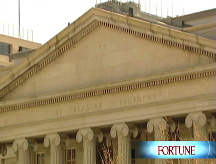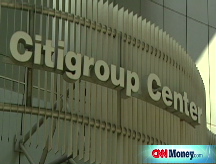Bonds hang in limbo
Treasurys mixed as investors digest news from the banking sector showing continued upheaval and a slew of economic reports.
NEW YORK (CNNMoney.com) -- Government debt prices traded in a tight range Thursday as investors weighed a slew of mixed economic data, turmoil in the banking sector and a growing supply of government debt coming to market.
"We have a lot of mixed data," said Mary Ann Hurley, vice president of fixed income trading at D.A. Davidson. And with bonds already expensive and corresponding yields low, investors hesitated. "Yields remain near the low end of the trading range which makes it hard for people to be buying Treasurys here," she said.
The government has taken unprecedented moves to try to prop up the nation's banks, including direct capital injections. But the sector continues to struggle, which has unsettled investors who are demanding Treasurys as a safe haven for their cash in an uncertain equity market.
Furthermore, a fresh wave of dour economic data also suggests to investors that it may not be time to move assets out of Treasurys.
On Wednesday, a couple of very weak retail sales reports indicated that the American consumer is not shopping. The reports weighed on sentiment, helping to push stocks lower and support bond prices.
And Thursday, the government released a report showing that the number of Americans who filed for unemployment benefits rose more than expected last week to 524,000, breaking the half-million mark for the first time in 2009. And another report showed that wholesale prices fell by 1.9% in December, largely dragged down by a dramatic drop off in energy prices.
And while the struggling banking sector and weak economic news propped up Treasury prices, an elevated supply of government debt coming to market kept a damper on the rally.
House Democrats negotiated the final details of an economic stimulus package that would cost $825 billion, including $275 billion in tax cuts and $550 billion in spending and help to states.
As the government spends at a fervent pace to prop up the economy, the supply of Treasurys coming to market will not slow down.
But the back and forth on the bailout wasn't affecting bond prices very much on Thursday, according to Hurley. "What is being proposed by Congress and what actually gets enacted may be two different things so the market wants to see what is actually enacted," she said.
Bank woes: JPMorgan Chase (JPM, Fortune 500) reported fourth-quarter earnings Thursday morning of 7 cents per share, which was slightly better than analyst expectations that the bank would break even. The New York-based bank's net income was 76% below the same quarter a year earlier.
Citigroup (C, Fortune 500) was expected to post a loss when it reported Friday. News that the giant bank plans to sell a majority stake in its brokerage division, Smith Barney, to Morgan Stanley, brought up questions about the fate of the firm, once a major stronghold on Wall Street.
Bank of America (BAC, Fortune 500) is reportedly asking the government for even more cash in order to cover the losses of Merrill Lynch, which it recently acquired.
According to a report from the Wall Street Journal, Charlotte, N.C.-based Bank of America may not be able to complete the deal without more capital from the Treasury.
"We are going to continue seeing problems in the financial sectors which ultimately should be a positive for bonds," said Hurley. Instability in the financial markets pushes investors to the safe haven of Uncle Sam's debt.
However, the more the government spends to prop up the failing economy, the more government debt comes to market. "We are going to see increased deficit spending to continue to have the bailout in the financial sector," said Hurley.
Debt prices: The benchmark 10-year bond fell 4/32 to 113-17/32 and its yield rose to 2.21% from 2.2% late Wednesday. Bond prices and yields move in opposite directions.
The 30-year bond increased 15/32 to 132-9/32 and its yield fell to 2.87% from 2.89%. The longbond surged almost three points Wednesday.
Meanwhile, the 2-year note eased 2/32 to 100-8/32 and its yield rose to 0.75% from 0.72%.
And the yield on the short term 3-month bill recovered to 0.12%, even with late Wednesday. The 3-month note is considered a gauge of investor confidence because money market funds tend to shuffle cash into and out of the bill as they assess the risk in other parts of tech marketplace. A lower yield indicates higher demand.
Lending rates: Bank-to-bank lending rates have fallen significantly as the government has worked to increase liquidity and confidence in the system, but Thursday, the trend reversed and rates ticked slightly higher.
On Thursday, the 3-month Libor rate was 1.09%, up slightly from 1.08% Wednesday, according to data available from Bloomberg.com. And the overnight Libor rate was 0.12%, up slightly from 0.10% Wednesday.
Libor - the London Interbank Offered Rate - is a daily average of rates 16 different banks charge each other to lend money in London, and it is used to calculate adjustable-rate mortgages. More than $350 million in assets are tied to Libor.
Two credit market gauges were mixed.
The "TED spread" increased to 0.97 percentage point from to 0.96 percentage point Wednesday. The higher the spread, the less willing investors are to take risks. The rate widened to historic levels as the credit market froze in the fall. As central banks around the world have eased lending rates and worked to increase liquidity in the marketplace, the spread has come back down.
Another market indicator, the Libor-OIS narrowed to 0.90 percentage point from 0.91 percentage point late Wednesday. The Libor-OIS spread is a measure of how much cash is available for lending between banks, used for determining lending rates. The bigger the spread, the less cash is available for lending.
Commercial paper: A combination of government programs have helped to open up the credit markets since they became log jammed in the fall.
One government program, the Federal Reserve's Commercial Paper Funding Facility, which started in late October, allows companies to sell highly rated 3-month debt to the government in exchange for ultra-low interest rates.
Commercial paper is short-term debt that big businesses and financial institutions issue to pay for day-to-day business operations like payroll and utilities. The debt was traditionally purchased by institutional investors as a safe and secure asset, but since Lehman Brothers' demise, investors have been more hesitant to purchase the paper, leaving some companies unable to get the cash they need to meet their daily responsibilities.
A Fed report released Thursday showed that business lending contracted in the second week of the new year, after surging in the first week of the new year. The amount of so-called commercial paper that was sold in the seven days ended Jan. 14 fell by $45.8 billion, or 2.6%, to a seasonally adjusted $1.72 trillion.
How do you think Barack Obama's presidency will affect you and your wallet? What can he do to help you - and others - in these trying economic times? E-mail us at realstories@cnnmoney.com, and your thoughts could be part of an upcoming story. ![]()




